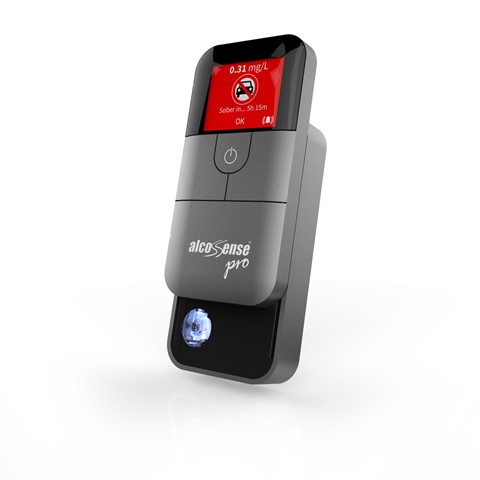AlcoSense Breathalyser – Excel, Pro & Ultra
AlcoSense.co.uk
Have you ever found yourself contemplating your drive home, and you’ve not been 100% sure whether or not you were below the legal limit? For example, the morning after a night of drinks, how can you tell when you’ve waited long enough? With these personal breathalysers by AlcoSense, you no longer need to rely on shaky guess-work; you can test yourself before you drive, thus making sure you never break the law and take a risk that you shouldn’t have.
We were sent three breathalysers by AlcoSense – the Excel, the Pro and the Ultra. Clearly, there’s more in play here than the simple binary of ‘Is this a breathalyser that works or isn’t it?’. So, we have these breathalysers a go: how do they work, what makes them different to other breathalysers, and what sets the different models we received apart from each other?
AlcoSense Excel
£99.99

The AlcoSense Excel uses the same sensor as the police use for their breathalysers – it's just smaller (64mm² version of exactly the same 200mm²). This means it’s twice as accurate as its predecessor, the AlcoSense Elite. Having the same sensor to hand as the police are using gives you a reading you can rely on – not only is it accurate to your actual inebriation levels, but it will be extremely accurate to whatever reading the police would be getting, which, let’s be honest, is important to know. This fuel cel is the type used by police in the EU, US and the UK.
A clever detail about the Excel and all of the AlcoSense sensors is that you can set it to any drink/drive limit in the world, making sure that its results are accurate to the laws in your country or state. (It’s also a fun game to see how different these rulings can be.) Slightly annoyingly, on the Excel, this has to be set manually – in other words, you need to program in the perimeters, rather than being able to simply select a country name. However, there is a helpful chart of country limits in the user manual.
The company warns that many breathalysers claim to use ‘police sensors’, when all they mean is that their breathalyser uses a fuel cell sensor of some kind. However, such sensors vary, whereas with the AlcoSense Excel, you know for a fact that you’re getting the exact same brand and type of sensor as the police us – it's just smaller. This is far less variable than using another make of fuel cell sensor and claiming its outcomes are the same.
But apart from this, what makes the breathalyser accurate? The main area is related to what part of your lungs the air is measures has come from, and how it calculates this. The most accurate way to test someone’s breath is to measure their deep lung air – to reach this, a person must have exhaled a litre of air first, to empty the surface lunge air. Many breathalysers calculate this using a timer – after exhaling for X amount of time, you’re good to go. However, the AlcoSense Excel actually measures the volume of air you have exhaled. Far crazier, the device event accounts for temperature, such as compensating for heat waves or extreme frosts, as these changes in ambient temperature can otherwise change a reading.
Another appealing element of this breathalyser is its screen readout, which makes everything extremely easy to follow, from a very clear red or green graphic to show you whether your result means you’re safe or unsafe to drive. A detail I appreciate is that it also pops up with a yellow graphic if you’re dancing close to the limit: so, you don’t have to worry that you’ll get a green reading, have another drink and then be straight in the red – if it’s nothing strong, you should see a yellow warning first that tells you to stop.
The screen also makes instructions clear, such as telling you when to keep blowing, and if something about the device hasn’t been set up properly. This screen also makes the menus easy to access, which is useful for programming in your settings.
As well as being accurate from the get-go, the AlcoSense Pro actively helps you to keep it that way. For example, whilst the breathalyser compensates for temperate shifts, some temperatures can take it outside of its operation limits (it operates between 5°C~40°C.) If the ambient temperature might affect your result, the device will alert you and won’t let you do the test. You also can’t perfect a test with this breathlyser if the sensor is currently suffering from ‘saturation’ - something that can happen if you take a test too soon after drinking a beverage, and therefore still have alcohol particles in your both. You will be given a warning and the unit won’t let you use it until the sensor has recovered. Finally, the unit will also let you know if it needs recalibration, which prevents it from ever becoming inaccurate. These devices need recalibrating every year in order to stay reliable, but thankfully, all you need to do is mail them to the company, and AlcoSense will return them to you within five working days.
Lastly, the AlcoSense Excel can remember up to your last 24 readings, which might be useful if you’re being queried.
Phew! I didn’t realise a breathalyser could have so many features – and the Pro and Ultra have even more.
4.5/5
Pros:
Accurate reading
Clear read-out graphics
Gives read-out data in many ways
Accurately measures for deep lung air
Changeable drink-drive restrictions, to be usable in any country
Won’t run if too hot/cold or saturated to be accurate
Re-calibration alarm
Same fuel cell sensor as police use – just smaller
Cons:
Have to manually enter drink-drive legal restrictions
Only remembers 24 tests
AlcoSense Pro
£149.99

Like the Excel, the Pro uses a smaller, but otherwise exact, version of the same fuel cell sensor used by UK, US, and Eu law enforcement. The Excel has a 4mm² version of the police’s 200mm²: the Pro uses 121mm2 In many ways, these devices are similar, but the leap in price-point is for a number of reasons, which we’ll break down here.
First of all, unlike the Excel, this device no longer requires the absolute faff of having to enter in the drive/drive requirements of the country or countries you’ll need it for. Instead, finally, it has database of countries and states that you can select from. This is particularly useful if you travel and cross borders, because you’re saved the Excel’s set-up hassle every time you go somewhere near.
Another new feature in the Pro is that it has an alarm system – most specifically, it uses your result to calculate how long it should be before you sober up, and will sound a Retest alarm when it should be time. Yet another feature is the amusingly named BlowCoach – this tells you whether you are blowing into the device too hard or too softly, giving you a visual of how you’re doing so you can get the most accurate possible readout from the sensor. This is a very useful feature, but it’s hard not to snigger about it a little.
Lastly, a vast improvement on the Excel’s 24, the Pro can remember your last 128 test results. In all other things, the Pro and Excel are the same: there’s nothing the Excel has that the Pro is lacking. Its areas of improvement are clear – the country selection, in particular, sets this device above the Excel for me. Helpfully, in a nice little touch, despite this country menu selection, you can still enter a limit manually if you’d like to give yourself a personal, more cautious limit of some kind.
All in all, this seems like the best choice for someone who travels, as well as anyone who needs this for personal use, and wants an accurate, thorough and easy-to-use experience.
5/5
Pros:
Accurate reading
Clear read-out graphics
Gives read-out data in many ways
Accurately measures for deep lung air
Selectable restriction laws by country
Can enter own personal limits
Sober and Retest alarm
Won’t run if too hot/cold or saturated to be accurate
Re-calibration alarm
Same fuel cell sensor as police use – just smaller
Remembers 128 tests
BlowCoach to make sure you breath correctly
AlsoSense Ultra
£249.99

The highest-priced in the lineup, the Ultra takes everything the Excel and Pro offer, and then boosts them to a professional level.
An immediate difference in the Ultra is that its fuel cell sensor is 200mm², meaning it is the exact same as the one used by the UK, US and EU law enforcement – no ifs, ands or buts. This fuel cell is used as a law enforcement standard for a reason, so you can trust that if it’s good enough for the police, it’s probably good enough for you too.
Technically, the Ultra remembers the same number of tests as the Pro (128), but unlike the Pro,you are able to download your results to your PC, which effectively means there is no cap on how many you can store! This is extremely useful if you need to provide a log to anyone, such as an employer: in fact, AlcoSense designed the Ultra with professional drivers in mind. This is also why the device comes with 100 extra mouth pieces – this is ideal if you intend to use this device yourself a lot, as well as being hygienic if you are a company that wants to use one of several Ultras to provide tests for your drivers as needed. The sampling system is a cut-above, and lastly, it comes with an additional carry-case to make sure your investment stays safe.
This product is definitely the best choice if you are looking for a professional-level operation. I would recommend this to anyone who drives as a part of their job – especially if it is the central element.
4.8/5
Pros:
Same fuel cell sensor as police use
Remembers 128 tests
Test results can be stored on PC
Accurate reading
Clear read-out graphics
Gives read-out data in many ways
Accurately measures for deep lung air
Selectable restriction laws by country
Can enter own personal limits
Sober and Retest alarm
Won’t run if too hot/cold or saturated to be accurate
Re-calibration alarm
BlowCoach to make sure you breath correctly
100 extra mouth pieces
Comes with a carry cae
Cons:
High price point
- Log in to post comments

